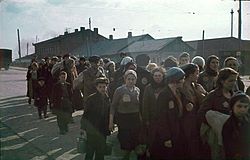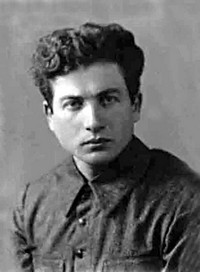


The Minsk Ghetto was created soon after the German invasion of the Soviet Union. It was one of the largest in the Byelorussian SSR, and the largest in the German-occupied territory of the Soviet Union.[1] It housed close to 100,000 Jews, most of whom were murdered in The Holocaust.
The Soviet census of 1926 showed 53,700 Jews living in Minsk (constituting close to 41% of the city's inhabitants).[2]
The ghetto was created on 28 June 1941, soon after the German invasion of the Soviet Union and capture of the city of Minsk, capital of the Byelorussian SSR.[2] On the fifth day after the occupation, 2,000 Jewish intelligentsia were massacred by the Germans; from then on, murders of Jews became a common occurrence.[2] About 20,000 Jews were murdered within the first few months of the German occupation, mostly by the Einsatzgruppen squads.[1]
On 17 July 1941, the German occupational authority, the Reichskommissariat Ostland, was created. On 20 July, the Minsk Ghetto was established.[3] A Jewish Council (Judenrat) was established as well.[2] The total population of the ghetto was about 80,000 (over 100,000 according to some sources), of whom about 50,000 were pre-war inhabitants, and the remainder (30,000 or more) were refugees and Jews forcibly resettled by the Germans from nearby settlements.[1][2][3]

In November 1941 a second ghetto was established in Minsk for Jews deported from the West, known as Ghetto Hamburg, which adjoined the main Minsk ghetto.[2] Above the entrance to this separate ghetto was a sign: Sonderghetto (Special Ghetto). Every night the Gestapo would murder 70–80 of the new arrivals. This ghetto was divided into five sections, according to the places from which the inhabitants came: Hamburg, Berlin, the Rhineland, Bremen, and Vienna.[2] Most of the Jews in this ghetto were from Germany and the Protectorate of Bohemia and Moravia; the largest number it held at once was about 35,000 residents.[1][2][3] Little contact was permitted between the inhabitants of the two ghettos.[1][2][3]


As in many other ghettos, Jews were forced to work in factories or other German-run operations.[3] Ghetto inhabitants lived in extremely poor conditions, with insufficient stocks of food and medical supplies.[2]
On 2 March 1942, the ghetto's nursery or orphanage was "liquidated"; the children were buried alive in a pit after the murderers had tossed them candy:[4]
At that moment, several SS officers, among them Wilhelm Kube,[5] arrived, whereupon Kube, immaculate in his uniform, threw handfuls of sweets to the shrieking children. All the children perished in the sand.[6]
In March 1942, approximately 5,000 Jews were killed nearby where "The Pit" memorial to the Minsk ghetto now stands. On 31 March, the Germans raided the ghetto to arrest Resistance leaders, and much of the ghetto, including the synagogue, was burned.[4]
By August, fewer than 9,000 Jews were left in the ghetto, according to German official documents.[2] The ghetto was liquidated on 21 October 1943,[2] with many Minsk Jews perishing in the Sobibor extermination camp.[3] Several thousands were massacred at Maly Trostenets extermination camp (before the war, Maly Trostenets was a village a few miles to the east of Minsk).[3]
Approximately fifty German and Austrian Jews from the Sonderghetto survived the war, mostly young men who were deported from the ghetto to Poland. There were only a few Jewish survivors in the city when the Red Army retook it on 3 July 1944.[2]

The Minsk Ghetto is notable for its large scale resistance organization, which cooperated closely with Soviet partisans. About 10,000 Jews were able to escape the ghetto and join partisan groups in the nearby forests.[1][2][3] Barbara Epstein estimates that 30,000 Jews escaped the Minsk Ghetto to join the partisans with half of them accounted for. It is unknown if the remaining half escaped successfully or not.
|
| |||||||||||||||||||||||
|---|---|---|---|---|---|---|---|---|---|---|---|---|---|---|---|---|---|---|---|---|---|---|---|
| |||||||||||||||||||||||
| |||||||||||||||||||||||
| |||||||||||||||||||||||
| |||||||||||||||||||||||
| |||||||||||||||||||||||
|
| |||||||||
|---|---|---|---|---|---|---|---|---|---|
| Groups |
| ||||||||
| Synagogues |
| ||||||||
| Yeshivas |
| ||||||||
| The Holocaust |
| ||||||||
| |||||||||
|
| |||||||||||||||||
|---|---|---|---|---|---|---|---|---|---|---|---|---|---|---|---|---|---|
| People |
| ||||||||||||||||
| Groups |
| ||||||||||||||||
| Crimes |
| ||||||||||||||||
| Records |
| ||||||||||||||||
53°54′35″N 27°32′34″E / 53.9098°N 27.5429°E / 53.9098; 27.5429